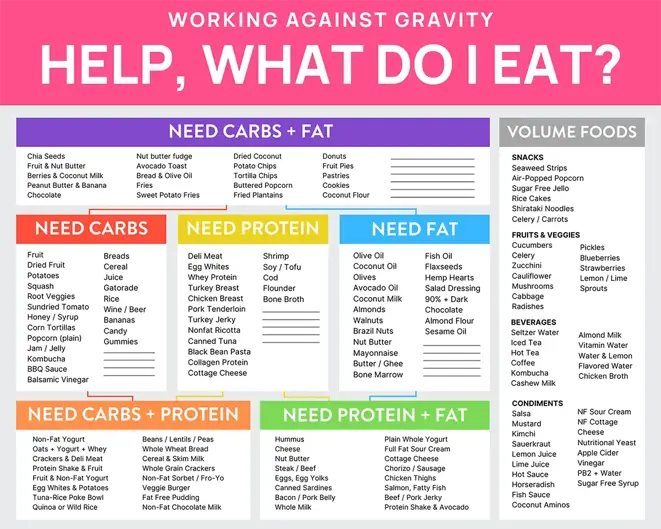
Macro tracking is recording the amount of protein, carbohydrates, and fats you eat daily. In this guide to macro tracking for beginners, we're breaking down what macros are, where to find them, how to start counting macros, and spilling our secret sauce for how we set macros so you can determine your starting place.
Whether your goal is to lose weight and change your body composition or increase your muscle mass and improve performance in the gym, being deliberate about the type and amount of food you use as fuel is a great way to build a long-term, sustainable approach to nutrition. Best of all, it can also be personalized to you and your goals!
Gone are the days of a “one-size-fits-all” approach. But where do you start? Let’s run through a step-by-step of macro tracking for beginners so you can hit the ground running!
What are Macros?
The three macros are protein, carbohydrates, and fats. They are the building blocks of food, and each of them serves a specific function in your body.
Advertisement
Each macro consists of calories—this is why you’ll often hear the phrase, “Not all calories are created equal” when reading about macro tracking for beginners. It’s a universal truth.

The “best” macro ratio depends on factors like your body, goals, and food preferences. Click below to calculate yours for free!
Protein
Protein helps support lean muscle mass growth and retention. It also contains essential amino acids that help your muscle to fully repair and recover from daily use and intense training sessions. It is involved in hormone and enzyme production, and it is also the most satiating macro—a diet high in protein that helps keep hunger at bay.
Carbs
Carbohydrates are your body's most readily available energy source, whether it is the fuel needed for basic bodily functions (like breathing, digestion, and more) and for living your everyday life or training. For athletes who compete in endurance sports or higher-volume exercise, carbs work to replenish glycogen stores in your muscles that deplete throughout your session. This translates into better recovery and higher levels of performance.
Advertisement
Fat
Omega fatty acids such as EPA and DHA help to support cardiovascular health, joint health, and also aid in digestion. Further, fat-soluble vitamins A, D, E, and K require sufficient dietary fat in order to be properly absorbed by the body. Fats also help to keep your hair and nails strong and promote skin health.
Tracking macros ensures you eat enough of each macro and optimize your nutrition to support your goals—whether that’s losing body fat, gaining strength and muscle mass, or improving performance in a chosen sport.
While on the surface, it might appear as if eating within the framework of a macro prescription would be restrictive, it can be quite the opposite.
Nothing is “off limits" with a flexible dieting approach, and finding a balance between what you enjoy and what your body needs helps you achieve nutritional freedom while still working towards your goals!
Sound too good to be true? It’s not as complicated as you might think. Follow these simple steps to get started.
Advertisement
Why Should You Track Macros?
Tracking macros is one of the easiest ways to accomplish specific fitness, body composition, and weight-driven goals. A calorie deficit is key to weight loss, but how do you know that you are maintaining that deficit?
For muscle growth, your system needs a calorie surplus and the correct amount of protein to create lean mass, but does your daily intake align with those levels? What if you’re trying to maintain weight and enjoy a healthier lifestyle?
Without the concrete data of what you’re consuming from day to day, it becomes educated guesswork at best and a complete craps shoot at worst. By learning to track macros, you can tailor your intake to align precisely with your long-term goals and adjust as necessary when and if your goals (and body) change.
If you follow our maco counting tips, work hard to maintain high levels of adherence, and build consistency over the long term, you can be confident that your daily inputs will lead to your desired outcome.
Advertisement
Calories In/Calories Out
"Calories in/Calories out" is something you’ve probably heard when people discuss weight loss and nutrition. The problem with a nutrition approach that only revolves around calorie counting is that food quality matters. You could, in theory, reach your weight loss goals by eating nothing but fast food and highly processed junk, but that will leave several benefits on the table.
- Tracking macros ensures you have the right protein, carbs, and fat balance to optimize progress toward your established goal.
- By only tracking calories, you could miss out on vital micronutrients important for your body's key processes. A lack of these micros will also mean you’re not feeling or performing your best!
- When it comes to body composition, macros matter. If what you see in the mirror is as essential as the number on the scale, counting calories simply doesn’t deliver.
- In our experience, macro tracking for beginners is easier than counting calories!
Getting Started with Macro Tracking
While on the surface, it might appear as if eating within the framework of a macro prescription would be restrictive, it can be quite the opposite. Nothing is “off limits" with a flexible dieting approach. Once you learn how to track macros, the process becomes second nature, and incorporating the foods you enjoy is a breeze. This means you can achieve your goals while also enjoying nutritional freedom!
Sound too good to be true? It’s not as complicated as you might think. Macro tracking for beginners is as easy as following these simple steps:
Set Your Macros
You have two options here.
Advertisement
If you want to shift the “heavy lifting” to us, sign up for 1-on-1 nutrition coaching with Working Against Gravity. One of our certified experts will get to know you, your body, your goals, and so much more, then build, monitor, and adjust a customized program.
Not quite ready to dive into personalized programming and ongoing accountability? Calculate your own macros for free here, or dive into the specifics of counting macros for weight loss with this in-depth guide.
Your daily macro needs will be determined by your goals. What is most important to you right now? Make that determination before you start crunching numbers!
Track Your Intake With a Food-Tracking App
This is where you’ll actually “track” your macros. Record your food in a food tracking app as you eat and measure it. Your app has a food database that will tell you how many grams of protein, carbs, and fats are in your food based on your portion sizes. Your app will also do the math for you as you eat to let you know how many macros you’ve eaten and how many you have left.
Our go-to tracker is MacrosFirst. Built from the ground up with macro tracking in mind, this free app includes a comprehensive food database, an easy-to-use interface, a food barcode scanner, precise target setting, and much more. Paid alternatives include MyFitnessPal or myMacros+.
Advertisement
(Starting to feel a little confused about calories, macros, grams, and ounces? This article will help!)
Head to the Grocery Store
Environment and preparation play an important role in the success of a macro-tracking approach to nutrition. Filling your fridge and pantry with whole, minimally processed foods ensures you have what you need on hand to reach your macro targets. Not sure which foods to buy for each macro? Check out our handy “Help! What Do I Eat?” infographic below!

We’ve also covered shopping at some of our favorite grocery stores, including Whole Foods, Trader Joe’s, Costco, and Woolworths.
Advertisement
Macro Tracking Tips For Beginners
Getting started is often one of the hardest parts of learning how to track macros, but with these macro counting tips, we keep things super simple so you can gradually build your confidence and skill sets.
Tip 1: Start Simple
As a beginner, it’s tempting to try and do everything at once. This is especially true when it comes to tracking meals. By starting slow and tracking a few meals per day, you will avoid getting overwhelmed with the amount of food that needs to be logged.
Start by including a protein, carb, and fat source at each of those three meals. There’s nothing worse than reaching the end of the day and finding you’re short in one (or multiple!) macros. Make sure to get all three macros in every meal, and you’ll set yourself up for success. When you’re just starting, dividing your macros relatively evenly through your meals can be helpful.
Tip 2: Pre-plan meals to stay within your targets
Log your meals ahead of time. Better yet, do a bit of meal prep! The further in advance you plan, the easier it is to hit your macro targets. Then, you can use your logs as a menu for your day and won’t feel like you’re spending too much time doing “Macro Tetris.”
Tip 3: Use a food scale for accurate portions
The more accurate you can be about measuring the foods going into your body, the more consistent and measurable your results will be. A food scale allows you to measure the food you eat in grams and ounces. This will help you determine how many macros you eat based on your portion sizes.
Advertisement
It might seem like extra work at first, but you have a few options if that is the case.
- Stick it out and give yourself time to get used to the added step. The more you do it, the easier and faster it will get. Remember, it is about progress over perfection.
- Try estimating portion sizes using your hands or by using cups and spoons. Then, move on to using a food scale.
- Take the macros out of it. Instead of stressing about actually hitting your macros, it can be helpful to track current intake while you get used to your food scale and tracking app (more on that below). Then, start aiming for targets.
Tip 4: Don’t stress about perfection - focus on consistency
Avoiding an all-or-nothing mindset is essential as a beginner macro tracker. While nailing down your macros with 100% accuracy is impressive, 65% is still better than 30%! Work to get in the habit of going through the motions - planning, prepping food where possible, and logging what you eat.
If the numbers don’t match up perfectly immediately, that’s okay! This is often the case with macro tracking for beginners. It’s completely normal when you’re starting. By laying down a foundation of consistency, you’re setting yourself up for higher accuracy.
Common Macro Tracking For Mistakes to Avoid
We've been in the industry for a decade and have helped over 30,000 people reach their goals. Here are some of the most common mistakes we've seen beginner macro trackers make.
Advertisement
Overestimating or Underestimating Portion Sizes
Macro tracking for beginners is incredibly challenging when it comes to portion sizing. Estimation is a skill set that needs to be developed! If it’s not, then when you’re caught out and about with access to a food scale, you can either over or underestimate the amount of food you’re consuming. Regarding progress, accuracy and consistency are key, and “close enough” is often not, in fact, close enough.
For the best results, weigh your food before you log it. For those times when you’re unable, your food logs will be a lot more accurate if you’ve spent significant time practicing your estimation.
A straightforward way to accomplish this is by guessing the weight of food when preparing a meal and then double-checking the actual weight on the scale. As you learn how different food types and portions relate to weight, the margin of error becomes smaller and smaller. This can give you the confidence to ditch the scale at family gatherings or other social events to be 100% present and enjoy yourself.
Ignoring Hidden Macros in Sauces and Snacks
One of the most crucial macro counting tips is being 100% honest with yourself. While it might be tempting to have a snack and then choose not to log it, just because you didn’t put it in the app, doesn’t mean those calories don’t count. The same goes for avoiding logging high-calorie add-ons like sauces, dressings, cooking oil, and butter. If you exclude those things often enough, they will add up, sabotaging your progress.
Remember, progress over perfection! Have that snack, and if it ends up that you didn’t plan well enough and it sends you over your macros for the day, use it as a learning experience and try again tomorrow.
Advertisement
Being Too Rigid and Not Enjoying Your Food
Food can be treated as a means to an end - fat loss, muscle gain, or simply a healthier lifestyle. But it is also so much more than that! So many of the joys in life revolve around events involving food. Birthdays, holidays, vacations, celebrations - the list goes on. If you are too strict about what you eat or how much flexibility is built into your approach, you’ll end up frustrated, burned out, and with a much higher chance of throwing in the towel altogether.
Remember, tracking macros is about sustainability and flexibility. You can have your cake and eat it too. Just work to plan ahead as much as possible and realize there is no impending deadline to reaching your ultimate goal. It’s a marathon, not a sprint.
Tools and Resources to Simplify Macro Tracking
Undertaking a new nutrition approach seems daunting, but it doesn’t have to be. In the same way you wouldn’t want to try building a house without a good hammer, you don’t want to tackle tracking macros without the tools of the trade. Let’s take a look at some macro counting tips to make the process a bit easier!
Food Scale
While estimating intake can be a serviceable approach, the more accurate you can be, the better results you will achieve. Don’t overthink this, though. You don’t need some top-of-the-line, smart scale with all of the bells and whistles.
Advertisement
A simple, well-made food scale supporting weight in grams will work fine. Your local supermarket or favorite online retailer will have plenty to choose from, so pick something that fits your budget and has a solid warranty. This thing is going to get some serious use!
Macro Tracking App
There are a myriad of options available when it comes to tracking apps, but a few of them have features that you won’t use or aren’t particularly useful for macro tracking. For instance, some put a more significant emphasis on total calories rather than the specific macro breakdown of foods. Others mostly list generic items, which can lead to tracking inaccuracies (and remember what we said about accuracy and progress!).
The best tracking app we’ve found, and the one we encourage all of our clients to use, is MacrosFirst. It is built from the ground up specifically for macro tracking and cuts out unnecessary fluff. The free version has everything you need, though there’s also a paid version if you want to dive deeper.
A second option is MyFitnessPal which features the most comprehensive database of food items, but be aware that you’ll need to upgrade to the paid version of the app to set specific macro goals (something free with MacrosFirst!)
Macro-Friendly Recipe Websites
One of the biggest challenges for beginners with macro counting is knowing what to cook. As you might know, not all food is created equal regarding nutrition quality, and finding solid recipes that fit within the framework of your numbers can be super challenging. Luckily, several websites specialize in whole-food recipes that fit the bill perfectly!
Advertisement
-
Working Against Gravity Recipes: We’ve spent years creating easy, delicious, macro-friendly recipes. From our viral “Crockpot Crack Chicken” to “Coconut Cream Pie Overnight Oats” we’ve got breakfast, lunch, dinner and snacks well and truly covered.
-
Skinnytaste: Broken down into nearly every imaginable category, Skinnytaste is one of the most comprehensive, macro-friendly recipe websites out there. For the easiest user experience, we recommend heading over to their recipe finder and sorting by main ingredient.
-
Oh Snap Macros: One of the biggest draws of Oh Snap is that their recipes are already loaded into both MacrosFirst and MyFitnessPal. This makes logging a meal super straightforward! The step-by-step visual instructions are also great for those who might not feel as confident in the kitchen.
Building a Sustainable Approach to Nutrition While Counting Macros
Learning the ins and outs of the flexible dieting approach and tracking macros will help you build the nutrition habits and skill sets that will last you a lifetime.
You don’t have to track macros forever (most people don’t!), but it does help you bring awareness to portion sizes and how much you need to eat based on your body, goals, training style, and other factors that play into overall health.
Advertisement
A 1-on-1 WAG Nutrition coach can help you take the guesswork out of what to eat and how to reach your macro targets. They’ll customize a program for you (after getting to know a lot more about you) and then check in with you each week to determine what is working and what isn’t, answer questions, and provide ongoing support, accountability, and program adjustments. Learn more about our membership options here.
Mitch Lockhart
Schedule a Free Intro Call
Working Against Gravity has led the macro tracking and health space for over a decade. Our team doesn’t just understand the science of nutrition—we’ve spent years mastering the art of tailoring it to fit your life. That means no cookie-cutter plans, just real strategies that have worked for over 30,000 people.
Schedule a free call with our team to learn how working with a 1-on-1 WAG coach will help you reach your goals.



